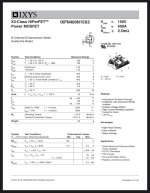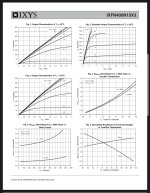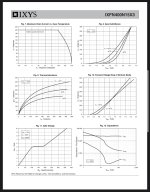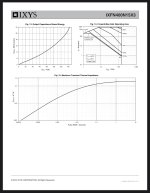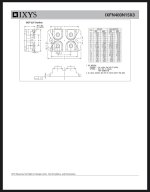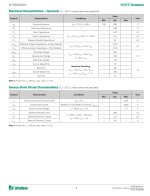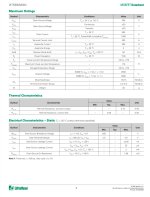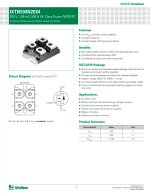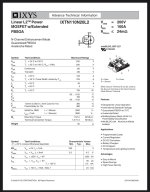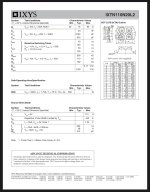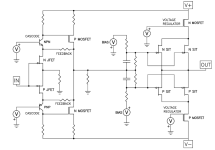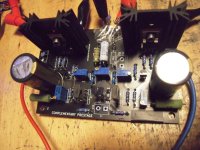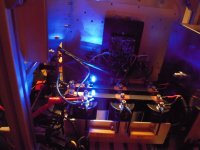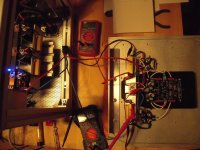I am contemplating using a pair IXFN400N15X3 in TO-227 packaging to replace the 6 IRF244 in my Aleph 5 build, to get away from the matching issue.
On paper it seems to be impressive RDS, lower than 3 IRF244 in parallel, VDS is lower but adequate for my Aleph 5, ID 400A, Qg higher than 3 IRF244, PD 695W.
Anyone knows if this is suitable as IRF244 replacement?
If some expert here could help with designing the output stage of the Aleph 5, I shall be happy to be the guinea pig to report the outcome, with fire extinguisher on standby, of course.
Here is the data sheet.
On paper it seems to be impressive RDS, lower than 3 IRF244 in parallel, VDS is lower but adequate for my Aleph 5, ID 400A, Qg higher than 3 IRF244, PD 695W.
Anyone knows if this is suitable as IRF244 replacement?
If some expert here could help with designing the output stage of the Aleph 5, I shall be happy to be the guinea pig to report the outcome, with fire extinguisher on standby, of course.
Here is the data sheet.
Attachments
Input capacitance may be high enough to cause issues such as high frequency roll off. It would take more current drive capability in the driver stage. Try them and report back. Inquiring minds want to know...
Indeed!
It is significant higher than 3 IRF244 in parallel, but not that much higher than 12 IRF244 in parallel in the Aleph 1.2.
Good observation!
It is significant higher than 3 IRF244 in parallel, but not that much higher than 12 IRF244 in parallel in the Aleph 1.2.
Good observation!
I would be careful. Besides the problematic input capacitance, most of these big beefy looking SOT packages are meant for switching operation and if you look at the DC performance in the SOA graph it's pathetic. Unless you really need 10A at 10V.
I would consult littelfuse.com, and find the so-called extended Forward Bias Safe Operating Areas (FBSOA) types. These are linear operation guaranteed. I am not sure what you're going to find because most of these, although they are in production, are not stocked by any of the usual places.
I would consult littelfuse.com, and find the so-called extended Forward Bias Safe Operating Areas (FBSOA) types. These are linear operation guaranteed. I am not sure what you're going to find because most of these, although they are in production, are not stocked by any of the usual places.
The matching issue is no big deal, so that should not be the motivation. If you want to play with the bigger chips,
I say OK, but maybe start with something a little more modest... 23 nF is quite a lot of capacitance.
I say OK, but maybe start with something a little more modest... 23 nF is quite a lot of capacitance.
Thanks Papa Pass for your kind advice.
It is indeed high, 50% higher than even with 12 IRF244 in parallel.
It is indeed high, 50% higher than even with 12 IRF244 in parallel.
Thanks Dirk! No I did not. But it is nice to know.
I was trying to build an Aleph 5 that is capable of driving low impedance speakers, hoping that it would deliver 200W@2 Ohm, and if possible, 400W@1 Ohm.
But matching the many transistors is a challenge, and I managed to overcome that, but the suppliers who sold me the 64 matched MOSFET, from more than a thousand MOSFET, whether it was an exaggeration or truth I wouldn’t know. He couldn’t sell me another batch of 64 matched MOSFET, even though I did pay a little premium for those.
But the next problem arises when I read somewhere that one can’t go more than 6~12 MOSFET, depending on the specific MOSFET, and I was giving on my earlier intent.
So your information just open another avenue for me. I am going to read up a bit more, hopefully could use the massive MOSFET to achieve my objective.
Would you be kind enough to share the amp that you built with the IXFN140N20P and the IXTN40P50?
I was trying to build an Aleph 5 that is capable of driving low impedance speakers, hoping that it would deliver 200W@2 Ohm, and if possible, 400W@1 Ohm.
But matching the many transistors is a challenge, and I managed to overcome that, but the suppliers who sold me the 64 matched MOSFET, from more than a thousand MOSFET, whether it was an exaggeration or truth I wouldn’t know. He couldn’t sell me another batch of 64 matched MOSFET, even though I did pay a little premium for those.
But the next problem arises when I read somewhere that one can’t go more than 6~12 MOSFET, depending on the specific MOSFET, and I was giving on my earlier intent.
So your information just open another avenue for me. I am going to read up a bit more, hopefully could use the massive MOSFET to achieve my objective.
Would you be kind enough to share the amp that you built with the IXFN140N20P and the IXTN40P50?
why you need 64 matched mosfets?
you need matched group of those sitting on same rail
so, even for Aleph having 12 pairs in OS, you need one matched dozen and another matched dozen
no use and no need to have all 24 matched
you need matched group of those sitting on same rail
so, even for Aleph having 12 pairs in OS, you need one matched dozen and another matched dozen
no use and no need to have all 24 matched
Hello NE WAY,
my amp came out of the 'F4 beast builders thread'
https://www.diyaudio.com/community/threads/f4-beast-builders.300233/
and the Babelfish XA252 thread (Zen Mod)
https://www.diyaudio.com/community/...belfish-xa252-sit-babelfish-xa252-set.373443/.
I used the bias mechanism of Zen Mod and paired it with a pair (N-ch / P-ch) 'Hockeypuck'-MosFets from IXYS.
As the driver board I made something similar like Sony V-Fet -driverboard from Mr. Pass (see pic below).
Something like a cascoded BA-3-frontend.
If you want to build something crazy like this, I would use ZEn Mods boards (Babelfish XA252 full Mos).
Cheers
Dirk
p.s.: and be sure, that you need a lot of aluminum / heatsink for the IXYS-Mosfets biased to 2.7 A!
my amp came out of the 'F4 beast builders thread'
https://www.diyaudio.com/community/threads/f4-beast-builders.300233/
and the Babelfish XA252 thread (Zen Mod)
https://www.diyaudio.com/community/...belfish-xa252-sit-babelfish-xa252-set.373443/.
I used the bias mechanism of Zen Mod and paired it with a pair (N-ch / P-ch) 'Hockeypuck'-MosFets from IXYS.
As the driver board I made something similar like Sony V-Fet -driverboard from Mr. Pass (see pic below).
Something like a cascoded BA-3-frontend.
If you want to build something crazy like this, I would use ZEn Mods boards (Babelfish XA252 full Mos).
Cheers
Dirk
p.s.: and be sure, that you need a lot of aluminum / heatsink for the IXYS-Mosfets biased to 2.7 A!

Attachments
Not to be a wet blanket, but I am not convinced by this plan.200W@2 Ohm, and if possible, 400W@1 Ohm.
My question would be: What kind of speaker does NE WAY want to drive, that dips down to 1 Ohm - close to a short? Hmmm 



Maybe a pair of Dayton Wrights.
In any case it's pretty easy to get 0.1v matching, as they tend to come out of the tube that way.
In any case it's pretty easy to get 0.1v matching, as they tend to come out of the tube that way.
I put my Sony VFET N-ch into service this winter powering my Martin-Logan 11A electrostats. (Normal winter amp is DIY F5.) Though the MLs are really pretty efficient (91dB sensitivity) and have self-powered woofers, they still have the very low impedance and the typical ES reactive load characteristic (0.6 ohms at 20kHz). Yet I'm really impressed how well this combination works; I'm liking the sound better than with the F5. If I swap the amps back, maybe I won't notice any loss, but I'm too pleased now to want to bother changing anything.
Also endorse NP's suggestion to put an o'scope across speaker terminals (if it's safe to earth ground one side, or if you have a battery scope), and get an idea of the voltage swings while you're actually listening at levels you like. You can conservatively guess an impedance to get watts. Probably will surprise you.
Also endorse NP's suggestion to put an o'scope across speaker terminals (if it's safe to earth ground one side, or if you have a battery scope), and get an idea of the voltage swings while you're actually listening at levels you like. You can conservatively guess an impedance to get watts. Probably will surprise you.
Yes and no, I started with a modest target, and the 64 MOSFET that I got fit in nicely with 32 MOSFET per channel, calculated using the spreadsheet that a kind gentleman on this forum shared, delivering 60W@8 Ohm and 480W@1 Ohm(theoretically).why you need 64 matched mosfets?
you need matched group of those sitting on same rail
so, even for Aleph having 12 pairs in OS, you need one matched dozen and another matched dozen
no use and no need to have all 24 matched
Then I got greedy, I thought that the MOSFET only need to be matched on one channel (just as you said), and if I get another matched 64 then I will be able to get 100W@8 Ohm, 800W@1 Ohm. That was when I am told that he couldn’t get another 64 matched.
The rest is history now that I read that I can’t use more than 12 in one channel due to Ciss being too large when more than 12 are connected in parallel together.
I am still tempted to try 32 MOSFET in one channel, that will still give me 50W ~ 60W@8 Ohm, and 400~480W@1 Ohm, if it works.
Attachments
You are probably right, but wouldn’t be fun to try and perhaps learn a thing or two from it.Not to be a wet blanket, but I am not convinced by this plan.
Thanks for the photograph. I was about to buy a pair of Apogee but someone beat me to it, so I settled for the Martin Logan which is a little easier on amplifier but not that much easier.My question would be: What kind of speaker does NE WAY want to drive, that dips down to 1 Ohm - close to a short? Hmmm
- Home
- Amplifiers
- Pass Labs
- IXFN400N15X3
